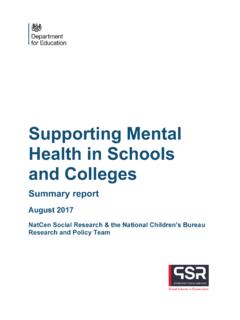Transcription of Coaching and emotions: How do coaches and …
1 Coaching and emotions: How do coaches and Coaching school directors engage and think about emotions? A project submitted to Middlesex University in partial fulfillment of the requirements for the degree of Masters in Work Based Learning Studies (Professional Coaching ) Katina Cremona Student No: M00218353 Project submitted April 2009 i-coach academy National Centre for Work Based Learning Partnerships, Middlesex University 2 Contents Summary page 3 Chapter 1 Introduction page 4 Chapter 2 Terms of Reference, Objectives and Literature Review page 6 Chapter 3 Methodology page 10 Chapter 4 Project Activity page 17 Chapter 5 Project Findings page 24 Chapter 6 Conclusions and Recommendations page 37 Bibliography page 43 Appendices 1 to 10 page 47 Key words.
2 Coaching , emotions, Coaching practices Word Count 12,429 words 3 Summary This research project set out to investigate how coaches and Coaching school directors engaged with emotions with their clients, and themselves, by exploring their approaches, assumptions and beliefs about emotions, and their views about the main influences on their approach. Related to this, the participants were asked about their perception of the boundary between Coaching and therapy in relation to emotions, and their ideal scenarios for coaches , the Coaching field, and organizations in which they worked. A case study methodology using semi-structured interviews was chosen to explore and understand the participants approaches, motivations, attitudes and meanings. A Grounded Theory approach was used to analyze the data and to develop theories and frameworks to make sense of the participants perspectives. Major conclusions from this study include: coaches use a variety of approaches to engage emotions in their clients and themselves.
3 Levels of engagement with emotions seemed to vary according to coaches comfort with emotions, their Coaching purpose, and how they defined the boundary between Coaching and therapy. All coaches stressed the importance of emotions, and a need for less judgment around emotions. These views were not necessarily connected with the depth and breadth of work they did with emotions. Four continuums were identified that summarized the different coaches approaches. Recommendations emphasized the importance of coach education around emotions and to assist coaches to consciously articulate their Coaching frameworks; for the Coaching field to clarify diverse definitions of emotions, Coaching , and therapy; and to deepen debates within the Coaching field by including people s assumptions and biases. Finally, potential future research included investigating the client and relationship factors that contribute to change; the value of experiential compared to intellectual learning around emotions; and continued research on the links between emotions and topics like resilience and dealing with change and uncertainty.
4 4 Chapter 1 Introduction The Coaching profession is a fast-growing area that attracts people from varied backgrounds who aspire to work in the field. Although there are increasing numbers of accreditation courses and bodies, at this stage, there are no restrictions on someone claiming to be a coach. Coaching can be a powerful mechanism for change but can also be carried out in a less effective manner, or at worst, in an unethical or potentially harmful way. Given this context, research into how coaches actually engage with, and think about, emotions is important. Very little research has been done that investigates this specific area. Despite prominent accreditation bodies such as ICF (International Coach Federation) and EMCC (European Mentoring and Coaching Council) requiring coaches to demonstrate skills in working with emotions, there seems to be some confusion and debate about whether working with emotions is equivalent to doing therapy or whether coaches should engage with emotions at all.
5 Investigating what coaches actually do in relation to emotions, and why, will contribute to this ongoing dialogue and bring more clarity. Related to this, there are ongoing discussions in the field about the difference between Coaching and therapy, and about whether non-psychologist coaches should use psychological techniques or be involved in psychological matters. Given that many coaches would define Coaching as being about change, it is important to know what the connection is, if at all, between the change process and working with emotions. If coaches are going to be engaged with emotions, then it is also important for there to be clarity about what is useful for helping people change and develop, and about the required competencies or credentials for varying levels of emotional work. This area also has relevance for leaders, managers and organizations especially given some of the same confusions and differing attitudes to emotions that appear to exist.
6 On a more personal note, being a psychologist and executive coach (and having been a psychotherapist), I continue to be on a journey of calibrating how I think about and approach emotions in my work as a coach which includes my Coaching framework. There is still much for me to learn about emotions in general, how best to work with them in a Coaching context, and what relevance they have for leadership and change. In both my personal and professional life, I have witnessed and experienced the power of articulating and accepting emotions, and their connection to the change process1. From growing up in my family and subsequent experiences, I have had a long-term fascination and interest in emotions and psychology. Since I see this topic as my 1 I have this personal bias because of my history as a therapist, and having experienced many years of therapy. On the one hand, talking about emotions is second-nature to me in my personal and professional life, and on the other hand, I have suppressed or limited this when I have conversed with people who did not have the same level of comfort or interest in emotions.
7 I therefore engaged with this research project with the view that this was my particular bias and wasn t suited to everyone. 5signature strength area, I would like to contribute to dialogue and debate in the Coaching field, and organizational life in general, and to the practice of Coaching . An integral part of my interest in Coaching is my experience and ongoing work teaching Coaching skills. I see this research project as an important input and catalyst to my writing more journal articles about Coaching and emotions, doing more informed Coaching skills training, and in furthering my development as a coach in general. 6 Chapter 2 - Terms of Reference, Objectives and Literature Review The research question for this project is: Coaching and emotions: How do coaches and Coaching school directors engage and think about emotions? The aims and objectives of this project (and therefore the interview questions in Appendix A) were designed to investigate: How coaches think about, and engage with, emotions in their clients and themselves.
8 This includes their assumptions and beliefs about emotions. What they see as the most important influences on their unique approach. coaches views about the difference between Coaching and therapy Where they would like to see changes, related to emotions, within the Coaching field and the organizations that they work in. The only term that was defined for the purpose of this research was emotions . Fineman (cited in Druskat, Sala & Mount, 2006, ), defines emotions as the personal display of affected states or emotional arousal ( , joy, fear, anger or embarrassment) and is differentiated from feelings which involve awareness of the arousal . In their desire to define emotions generally and inclusively, Ashforth and Humphrey (1995, ) define emotions as a subjective feeling state . This definition was used as the basis for defining emotions for this project. For the purpose of simplicity and not wanting to restrict the exploration of the coaches perspectives, emotions were defined as including emotions, moods and feelings, and as subjective feeling states that are conscious or unconscious.
9 - Background There has been a growing body of literature focused on the influence of emotions and moods on various aspects of our lives. For example, Damasio s (1994) work has shown that emotions are essential to decision-making and reasoning. Barbara Frederickson (2003) writes about positive emotions affecting our thinking processes, resilience and social connections. Even more targeted to the world of work, in 1996, Goleman first coined the term Emotional Intelligence and commercialized the importance of considering emotions in the workplace by writing his book, Emotional Intelligence: Why it can matter more than IQ. Mayer, Salovey and Caruso (2002) introduced the first emotional intelligence test which is based on decades of research into emotions. Their four branch model of emotional intelligence encompasses the abilities to: recognize, facilitate, understand, and manage emotions in ourselves and others. - The need for more attention and clarity regarding emotions Despite these and many other related developments, and the fact that the experience of work is saturated with emotion (Ashworth & Humphrey, 1997, ), there are 7several factors that contribute to Coaching practices related to emotions, receiving less attention than one might expect and to a need for more clarity.
10 These include: How emotions are judged Emotions can be perceived as irrational, signs of weakness and too soft for the business world. Coaching , by association, can easily be judged in the same way2. Kilberg (2000, ) states that ..individuals at senior levels in organizations believe and behave as though emotions have no place at work. The language, logic, and theory of business are couched in rationality, as if by talking only in those terms, human emotion can be obliterated from the workplace . He goes on to say that this is ironic given that everyone knows that the work environment produces extremely strong emotions . Goffee and Jones (2006) agree that organizations do not encourage emotions. They write that many who make their way up organizational hierarchies have been positively discouraged from exploring their emotional life ( ). People s emotional awareness and competence People are not good judges of their own emotional intelligence and can only be emotionally intelligent to the degree to which they are emotionally intelligent (Brackett, Rivers & Shiffman, 2006).







